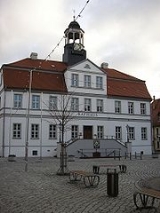
Bad Düben
Encyclopedia
Bad Düben (ˌbaːt ˈdyːbən) is a town in the district of Nordsachsen
in the Free State of Saxony
in Germany
. It is situated at the southern end of the national park Dübener Heide (Heath of Düben), between the rivers Elbe
and Mulde
, which runs through the city center.
castle of Dibni, with the first documented mention in 981. Fortifications around the castle led in time to the formation of the town at the Mulde. The town was the site of several historical events, including a battle in 1450 in the feud between Friedrich and Wilhelm von Thüringen, in which the old castle was completely destroyed. The legendary dispute between Hans Kohlhase
and Günter von Zaschnitz was settled in a court established in the town in 1533.
In 1631, during the Thirty Years' War
Gustav Adolf II
and John George I, Elector of Saxony
met in the town to forge an alliance against Ferdinand II, Holy Roman Emperor
.
Nordsachsen
Nordsachsen is a district in the Free State of Saxony, Germany.- History :The district was established by merging the former districts of Delitzsch and Torgau-Oschatz as part of the district reform of August 2008....
in the Free State of Saxony
Saxony
The Free State of Saxony is a landlocked state of Germany, contingent with Brandenburg, Saxony Anhalt, Thuringia, Bavaria, the Czech Republic and Poland. It is the tenth-largest German state in area, with of Germany's sixteen states....
in Germany
Germany
Germany , officially the Federal Republic of Germany , is a federal parliamentary republic in Europe. The country consists of 16 states while the capital and largest city is Berlin. Germany covers an area of 357,021 km2 and has a largely temperate seasonal climate...
. It is situated at the southern end of the national park Dübener Heide (Heath of Düben), between the rivers Elbe
Elbe
The Elbe is one of the major rivers of Central Europe. It rises in the Krkonoše Mountains of the northwestern Czech Republic before traversing much of Bohemia , then Germany and flowing into the North Sea at Cuxhaven, 110 km northwest of Hamburg...
and Mulde
Mulde
The Mulde is a river in Saxony and Saxony-Anhalt, Germany. It is a left tributary of the Elbe and 124 km in length.The river is formed by the confluence, near Colditz, of the Zwickauer Mulde and the Freiberger Mulde , both rising from the Ore Mountains...
, which runs through the city center.
History
Bad Düben's history goes back at least 1,000 years and traces its origins to the SlavicSlavic peoples
The Slavic people are an Indo-European panethnicity living in Eastern Europe, Southeast Europe, North Asia and Central Asia. The term Slavic represents a broad ethno-linguistic group of people, who speak languages belonging to the Slavic language family and share, to varying degrees, certain...
castle of Dibni, with the first documented mention in 981. Fortifications around the castle led in time to the formation of the town at the Mulde. The town was the site of several historical events, including a battle in 1450 in the feud between Friedrich and Wilhelm von Thüringen, in which the old castle was completely destroyed. The legendary dispute between Hans Kohlhase
Hans Kohlhase
Hans Kohlhase was a German historical figure about whose personality some controversy exists.He was a merchant, and not, as some have supposed, a horsedealer, and he lived at Cölln in Brandenburg ....
and Günter von Zaschnitz was settled in a court established in the town in 1533.
In 1631, during the Thirty Years' War
Thirty Years' War
The Thirty Years' War was fought primarily in what is now Germany, and at various points involved most countries in Europe. It was one of the most destructive conflicts in European history....
Gustav Adolf II
Gustavus Adolphus of Sweden
Gustav II Adolf has been widely known in English by his Latinized name Gustavus Adolphus Magnus and variously in historical writings also as Gustavus, or Gustavus the Great, or Gustav Adolph the Great,...
and John George I, Elector of Saxony
John George I, Elector of Saxony
John George I was Elector of Saxony from 1611 to 1656.-Biography:Born in Dresden, he was the second son of the Elector Christian I and Sophie of Brandenburg....
met in the town to forge an alliance against Ferdinand II, Holy Roman Emperor
Ferdinand II, Holy Roman Emperor
Ferdinand II , a member of the House of Habsburg, was Holy Roman Emperor , King of Bohemia , and King of Hungary . His rule coincided with the Thirty Years' War.- Life :...
.

